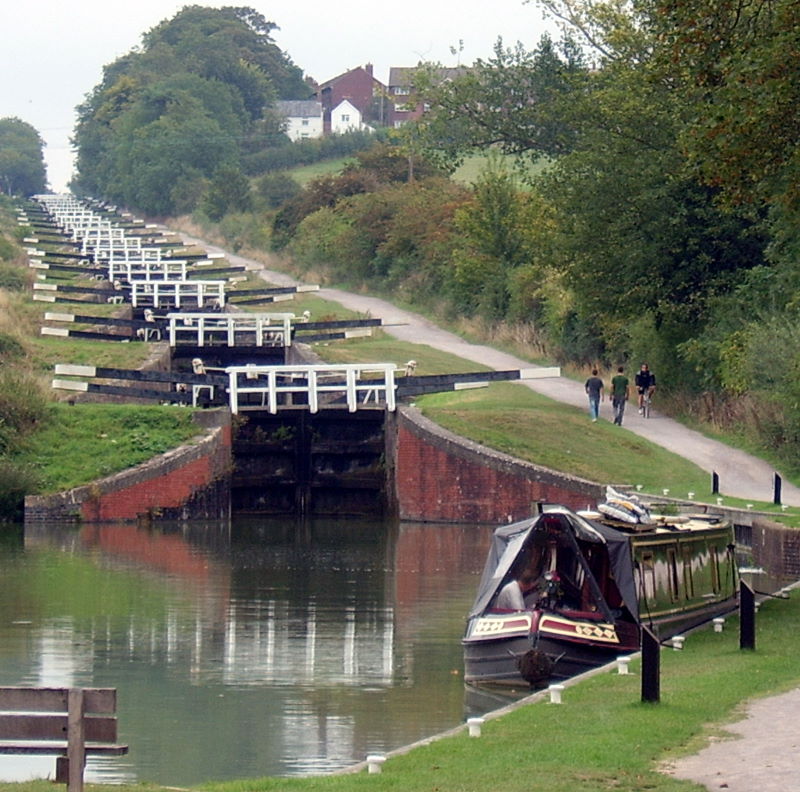Canal towpaths are often great for cycling, for four important reasons. They are flat; car-free; scenic; and they are generously punctuated with pubs.

When the countryside gets less flat, though, they’re sometimes less great for the narrowboats using them. The Kennet & Avon Canal – built in 1797–1810 as part of the vital waterways link between Bristol and London – has to elevate itself 72m in 4km just outside Devizes. It does so by way of 29 locks between the town and Foxhangers. On a good day at the canal equivalent of warp speed a boat might hurtle through them in three hours; on a bad day it might be all day.
On a bike, though, you get the best of all worlds. You can take in the towpath scenery at canal-boat pace – not quite breathtaking, though pleasantly English. But you can also scuttle up and down the best bit – Caen Hill’s aquatic escalator of 16 locks in a dead straight line – in a minute or two, enjoying the slightly bizarre experience of a long downhill canal. Freewheel all the way and you’d be going a fair lick at the end (so obviously, take it easy – there could be a lawyer with a grudge against cyclists and a baby buggy). But the gradient is pretty gentle, so it’s no great effort cycling up it either.

In the time you’ve done four circuits up and down, marvelled at the two-hundred year old technology still churning away sturdily, been into town for lunch, done another couple of circuits, and had a cream tea at the cafe, that pleasant middle-aged couple on the boat you chatted to earlier have advanced only five locks up the chain. (No wonder canal boat holidays are calming. You have no option but to set your internal metronome to a quarter-speed.)
This isn’t the longest flight of locks in the country. Tardebigge in Worcestershire has 30, as anyone who has navigated the Birmingham and Worcester Canal can tell you through gritted teeth. But Tardebigge lacks the visual impact of the Caen Hill flight, whose satisfying linearity would have brought tears to the eyes of a Roman engineer. There’s even a convenient place to photograph it: a little humpback bridge on the B3101 to Rowde, though there’s no way from the bridge on to the towpath.
There’s a café at the top, and also a car park, which is accessed from the B3101.
You can also park at the Wharf in Devizes town centre (above), where there’s the Canal Visitor Centre. You’ll find plenty of pubs in the town too, and the malty aroma of Wadworth’s the brewery responsible for 6X. (Which, clearly, is fifty per cent better than Australian lager.)
Devizes contrives to be nowhere near a rail station, so you may as well take the train to Bath and cycle from there; a day trip out on the Kennet & Avon towpath to Devizes and back is a full day of forty-odd miles, but it’s doable and at times stunningly beautiful.
Coming from Bath, you’ll see the Caen Hill flight rising majestically in front of you as you approach Devizes. Coming from Devizes, you have the slightly startling effect of looking down the flight over a sudden hilltop you didn’t realise you were on.
It may be two centuries old and still working as per the original sketches, done with quill pen by chaps in neckerchiefs, but we nearly lost all of this. Britain’s canal system fell into neglect through the 20th century, and like many other parts of the network, Caen Hill was derelict in the 1970s. Thanks to restoration work, much of it by volunteers, the lock system was good as new by 1990, completing the final link in the revival of the Kennet & Avon. A tribute to waterways patience.